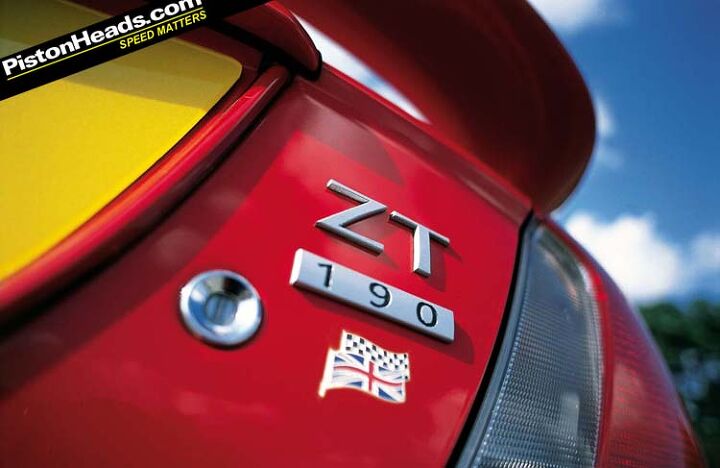MG ZT190 Review
This of course isn't MG's first badge engineering exercise. Although the Montego and Maestro only linger in our memories as beige nightmares, the MG badge did adorn the more tasty variants including the rather mental Tickford Turbo Maestro. Check them out here: MG Links
The UK ads for the MG-ZT promise 'fire breathing, full bodied, red blooded' pleasures. In a country where driving fast is as socially acceptable as puffing a Cuban cigar in a children's hospital, MG's message is welcome news for petrolheads. Still, let's not get carried away; it's only advertising. Or is it? Does the MG-ZT actually live up to the hype? Or is it an empty marketing exercise, shamelessly exploiting one of motor sport's most distinguished marques?
The entire concept is a bit worrying. The ZT is based on the Rover 75, BMW's ode to corporate hubris. No shade of eyeball assaulting paint can disguise the ZT's humble origins as a mid-market luxury barge built for the blue rinse and flat cap brigade. If ever a car was voted 'least likely to thrill anyone ever', the Rover 75 is it. And yet…
MG sent the demure 75 off to the School of Hard Looks for a first-class degree in Restrained Aggression. The graduate's mesh front grills and a lowered stance betray its high-speed aspirations without resorting to Japanese-style flared arches or razor-sharp wings. Subtle detailing and perfectly proportioned curves give the machine what MG [re]designer Peter Steven calls 'outside lane credibility'. Max Power Muppets have a better word for it: 'wicked'.
Inside, it's dull city. The ZT's interior is the automotive equivalent of those grey waterproof jackets favoured by England's elderly- totally practical and instantly forgettable. Someone in Rover's Marketing Department must have decided English retirees find oval shapes irresistibly soothing. Every single control is oval-shaped: air vents, gauges, horn, heater controls, door pulls, side mirrors, turning stalks, window buttons, the lot. There's plenty of space for luggage, but not enough rear legroom for a four-year-old.
The few attempts to inject a measure of sporting intent- the 'technical finish' fascia, the sports seats' lurid blue bolsters, the red on white dials – are less convincing than a coffee can exhaust on a Nova. Still, the doors clunk with Aryan solidity. There are no paint or glue drips, or nasty unfinished edges. Nothing broke, fell off, failed or rusted during my occupancy. The [thankfully] octagonal MG badge hasn't adorned anything this well built since, um, ever.
The ZT's racy gear knob may not overcome the interior's drabness, but it's connected to a five-speed Getrag gearbox that slots home like a rifle bolt. The slick shifter hooks you up to a 2.5 liter, 24-valve, transverse-mounted, quad cam, six-cylinder engine. Maximum power is 189bhp @ 6500rpms. As the torque figures indicate-181 ft. lbs. @ 4000rpms- the urge is evenly spread throughout the rev range.
For the non-technical, that's barely enough grunt for a lightweight roadster. Lest we forget, the ZT is a four-door saloon. Fifteen hundred kilos is an awful lot of weight for a small capacity six to schlep around. As a result, when it comes to speed, the ZT is only slightly more than merely adequate.
The 0 – 60 sprint takes 7.8 seconds. That's excellent compared to the Rover 75's 8.4 seconds, but laughable for a car that's supposed to brand you a hooligan. Standstill to the ton requires 22 seconds – a scant two seconds faster than a 2.5 litre Ford Mondeo. Hit the autobahn, stick the ZT in fifth, plant your foot and… you'll eventually achieve a hardly-worth-the-risk 141mph. Strangely enough, the gearing is biased towards cruising. When you leave the motorway and give it large, you'll be lucky to get 20mpg.
In its defense, the somewhat leisurely MG-ZT feels faster than the numbers suggest. The power delivery is smooth and satisfying, right up to the red line. Okay, the engine note is about as raucous as a night out with a Rover driver, but you're never left waiting for something to happen. Extracting maximum power is as simple as 'stamp, go, change; stamp, go, change'. The ZT's steering also helps maintain the momentum, providing just the right amount of feel and feedback.
MG's engineers have made the now familiar pilgrimage to the Nurburgring to fettle the ZT's suspension for ride quality and control. It was worth the trip; the Z-axle (rear) and McPherson struts (front) keeps things flat and happy through the twisties yet provide adequate comfort for the long haul. The car's ventilated discs are equally well sorted; you can scrub off speed like burnt egg off Teflon. The 18' wheels generate significant tyre roar, but it's a minor price to pay for such astounding levels of poise, grip and control.
The MG-ZT's systems all work harmoniously. A performance-minded driver will find it easy to extract maximum pleasure from the ZT's surprisingly tame power plant. In short, the MG-ZT is a well-built, mechanically sophisticated car, but not the rabid TVR-wannabe its advertising suggests. Not to put too fine a point on it, the MG-ZT is the perfect four-door for British enthusiasts with £20k to spend- as long as they forget the words 'Subaru Impreza Turbo'.
More by Robert Farago
Latest Car Reviews
Read moreLatest Product Reviews
Read moreRecent Comments
- Dr.Nick What about Infiniti? Some of those cars might be interesting, whereas not much at Nissan interest me other than the Z which is probably big bucks.
- Dave Holzman My '08 Civic (stick, 159k on the clock) is my favorite car that I've ever owned. If I had to choose between the current Civic and Corolla, I'd test drive 'em (with stick), and see how they felt. But I'd be approaching this choice partial to the Civic. I would not want any sort of automatic transmission, or the turbo engine.
- Merc190 I would say Civic Si all the way if it still revved to 8300 rpm with no turbo. But nowadays I would pick the Corolla because I think they have a more clear idea on their respective models identity and mission. I also believe Toyota has a higher standard for quality.
- Dave Holzman I think we're mixing up a few things here. I won't swear to it, but I'd be damned surprised if they were putting fire retardant in the seats of any cars from the '50s, or even the '60s. I can't quite conjure up the new car smell of the '57 Chevy my parents bought on October 17th of that year... but I could do so--vividly--until the last five years or so. I loved that scent, and when I smelled it, I could see the snow on Hollis Street in Cambridge Mass, as one or the other parent got ready to drive me to nursery school, and I could remember staring up at the sky on Christmas Eve, 1957, wondering if I might see Santa Claus flying overhead in his sleigh. No, I don't think the fire retardant on the foam in the seats of 21st (and maybe late 20th) century cars has anything to do with new car smell. (That doesn't mean new car small lacked toxicity--it probably had some.)
- ToolGuy Is this a website or a podcast with homework? You want me to answer the QOTD before I listen to the podcast? Last time I worked on one of our vehicles (2010 RAV4 2.5L L4) was this past week -- replaced the right front passenger window regulator (only problem turned out to be two loose screws, but went ahead and installed the new part), replaced a bulb in the dash, finally ordered new upper dash finishers (non-OEM) because I cracked one of them ~2 years ago.Looked at the mileage (157K) and scratched my head and proactively ordered plugs, coils, PCV valve, air filter and a spare oil filter, plus a new oil filter housing (for the weirdo cartridge-type filter). Those might go in tomorrow. Is this interesting to you? It ain't that interesting to me. 😉The more intriguing part to me, is I have noticed some 'blowby' (but is it) when the oil filler cap is removed which I don't think was there before. But of course I'm old and forgetful. Is it worth doing a compression test? Leakdown test? Perhaps if a guy were already replacing the plugs...




































Comments
Join the conversation